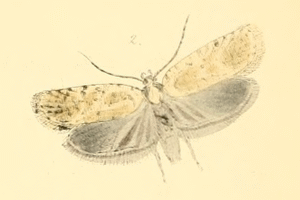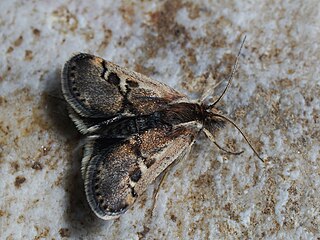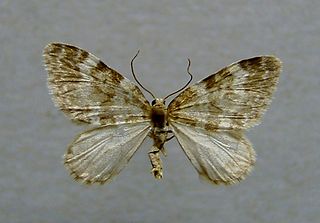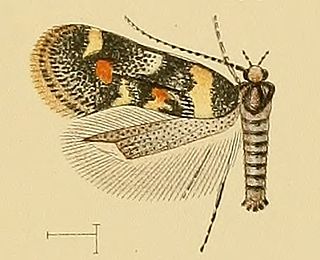Related Research Articles

Stenoptilia zophodactylus, also known as the dowdy plume, is a species of moth of the family Pterophoridae found worldwide. It was first described by Philogène Auguste Joseph Duponchel in 1840.
Atralata is a genus of moths of the family Crambidae. It contains only one species, Atralata albofascialis, which is found in most of Europe, except Ireland, Great Britain, Norway, Finland, Lithuania and Greece.

Stigmella mespilicola is a moth of the family Nepticulidae. It is found from Germany to the Iberian Peninsula, Italy and Macedonia and from Great Britain to Ukraine.
Parornix carpinella is a moth of the family Gracillariidae. It is found from Sweden to the Pyrenees, Italy and Greece and from Great Britain to Russia.
Parornix fagivora is a moth of the family Gracillariidae. It is found from Sweden to the Pyrenees, Italy and Albania and from Great Britain to southern Russia.
Caloptilia fribergensis is a moth of the family Gracillariidae. It is found from France, Germany, Poland and central Russia south to the Iberian Peninsula, Italy and North Macedonia.

Stagmatophora heydeniella is a moth in the family Cosmopterigidae. It is found in France, Germany, Switzerland, Austria, Italy, the Czech Republic, Poland, Slovakia, Hungary, Romania, North Macedonia, Ukraine and Russia.
Antispila treitschkiella is a species of moth of the family Heliozelidae. It is found from Great Britain to Ukraine and from Sweden to France, Italy and Greece. It is also found in Portugal.

Agonopterix nanatella is a moth of the family Depressariidae. It is found in most of Europe, except Fennoscandia, Poland, Ukraine, the Baltic region and most of the Balkan Peninsula.
Agonopterix senecionis is a moth of the family Depressariidae. It is found from Germany, the Baltic region and Russia to the Iberian Peninsula, Italy and Romania.

Orophia ferrugella is a species of moth in the family Depressariidae. It was described by Michael Denis and Ignaz Schiffermüller in 1775. It is found in most of Europe, except Ireland, Great Britain, the Netherlands, Portugal, Ukraine, Slovenia, and Greece.

Titanio normalis is a species of moth in the family Crambidae. It is found in Spain, Italy, Austria, the Czech Republic, Slovakia, Hungary, Croatia, Romania, Bulgaria, the Republic of Macedonia, Greece, Belarus, Russia and Turkey.
Dentifovea fulvifascialis is a species of moth in the family Crambidae. It is found in Greece, Lebanon, Israel and India.
Epascestria pustulalis is a species of moth in the family Crambidae. It is found in large parts of Europe, except Ireland, Great Britain, Norway, Finland, Denmark, the Benelux, France, Switzerland, Portugal, Slovenia and Croatia. It is also present in the Near East, including Lebanon and Turkey.
Acrolepiopsis tauricella is a moth of the family Acrolepiidae. It is found Italy, Switzerland, Hungary and Ukraine.
Digitivalva heringi is a moth of the family Acrolepiidae. It is found in Croatia and the Republic of Macedonia.
Antispila hikosana is a moth of the family Heliozelidae. It was described by Kuroko in 1961. It is found in Japan (Kyushu).
Antispila purplella is a moth of the family Heliozelidae. It was described by Kuroko in 1961. It is found in Japan (Kyushu).

Perizoma incultaria is a species of moth of the family Geometridae. It is found from the Alps to the Carpathian Mountains and the mountains of the Balkan Peninsula.

Chrysoesthia boseae is a moth of the family Gelechiidae. It is found on the Canary Islands.
References
- ↑ Fauna Europaea
- ↑ "bladmineerders.nl". Archived from the original on 2016-03-03. Retrieved 2012-03-29.